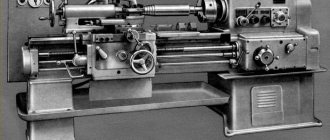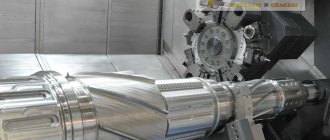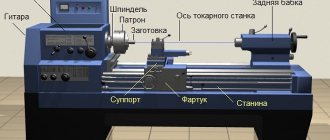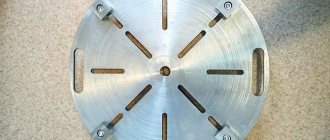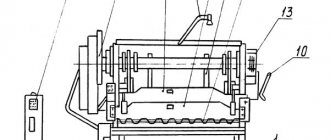provides a wide range of services in the field of repair of lathes. All work is carried out by professionals with extensive experience, who are well versed in all the nuances of repairing the hydraulic, mechanical, electronic and electrical parts of the device.
Today we carry out:
- repair of CNC lathes;
- repair of universal type screw-cutting lathes.
Our craftsmen will professionally carry out planned, routine or major repairs of turning equipment, and will do this in the shortest possible time, using reliable spare parts, components and consumables.
Overhaul of lathes
Does your turning equipment need a high-quality overhaul? Specialists will be happy to help you! They:
- Clean the machine from dirt.
- The device will be completely disassembled.
- All components and parts will be diagnosed.
- They will repair the lathe bed or any other components.
- Replace worn parts with new ones.
- They will polish the guides and, if necessary, carry out high-quality repairs to the guides of the lathe.
- Ball screws will be replaced or repaired.
- They will replace faulty electronic components or carry out a complete repair of the electrical equipment of the lathe.
- The machine will be assembled and prepared for work.
- They will comprehensively adjust all components and systems of turning equipment.
- The device will be brought to the planned accuracy.
- They will check the serviceability and trouble-free operation of the system.
- A trial part will be processed.
- They will paint in detail or carry out a complete painting of the machine.
Overhaul of a lathe in our company is carried out using professional equipment and tools.
Can compressed air be used when cleaning a CNC machine?
During daily maintenance of a CNC machine, it is important not only to perform the work efficiently, but also to apply as little effort as possible and spend as little precious working time as possible. Using a compressed air gun frees hard-to-reach areas of the CNC machine structure from dust and chips much faster, which allows cleaning to be done several times faster
However, manufacturers of CNC machines strongly discourage the use of compressed air during maintenance and cleaning, and there are several reasons for this:
- Dust and dirt, including that generated during the processing of MDF and lifted from the concrete floor, have good abrasive properties. By getting under high pressure jets of compressed air even into closed bearings of electric spindles, ball screws, linear guides and other mechanisms, abrasive dust significantly reduces their service life.
- Dust flying in a stream of compressed air can penetrate the electronic components of a CNC machine and settle on electrical contacts. After some time, the density of the layer of dust deposited on the contacts can reach a level at which the electronic device fails.
- Compressed air may contain drops of water, which, if they get on exposed metal parts of the machine, can cause corrosion, when interacting with the contacts of electrical switches and relay devices, they can cause oxidation, and if they penetrate inside complex electronic devices, they can cause a short circuit.
- The efficiency of dust collection with compressed air tends to zero, since lightweight fractions rise and hang in the air, and after some time settle on the surfaces of the CNC machine, on the floor, on workpieces, thereby making cleaning not only useless, but also inappropriate.
- Dust particles from wood chips and concrete floors raised into the air, entering a person’s lungs, are harmful to his health.
As a rule, when performing operations and maintenance of a CNC machine in the production of furniture and MDF facades, compressed air is used as the fastest and most effective way to clean work tables from chips and dust. To clean the remaining parts of the CNC machine using compressed air, you should follow some recommendations:
- You can only blow air on the milling spindle when the CNC machine is turned on. The fact is that modern spindles are connected to a compressed air system, which creates a high-pressure area inside them, thereby preventing dust from entering the bearings. Directing a jet of compressed air into the electrospindle shaft is prohibited.
- A chuck (mandrel) with any tool must first be installed in the quick tool change mechanism of the milling spindle.
- Near the location of bearings and electrical devices, a compressed air gun should be used at a maximum distance, sufficient only to blow off small loose fractions.
- It is prohibited to direct a jet of compressed air at the impellers of the spindle cooling systems or the electrical cabinet of the CNC machine.
- Before using a compressed air gun, you still need to use a vacuum cleaner, brush or cloth.
Thus, if these recommendations are followed, daily maintenance of the CNC machine will indeed be useful, including to ensure uninterrupted operation of the equipment and extend its service life.
Individual solutions for each customer
Of course, major equipment repairs are not always required. Sometimes it is enough to repair a single element or unit. Our company’s specialists are ready to help you in this case too! The craftsmen will begin repairing the lathe with a thorough inspection of it, as well as:
- check the general mechanical condition of all mechanisms and components;
- if necessary, eliminate the gap in the lead screws of the slide and table;
- adjust the spindle bearings or make the necessary repairs to the lathe spindle;
- check the serviceability of the gear and feed switching mechanisms;
- carefully inspect the guides and remove burrs;
- check the operation of limiting devices;
- adjust the gaps in the guides of the console, table and slide;
- will perform other types of work.
If such a need arises, the machine will be completely or partially disassembled, and then faulty components will be repaired, for example, the tailstock of a lathe will be repaired or bushings, shafts and other parts will be replaced.
What are our advantages?
occupies a leading position in the market. We have been working in Moscow since 2006. This is an important indicator that demonstrates professionalism and experience. Clients appreciate it and recommend our organization to business partners.
By contacting us, you will not regret it! We have important advantages:
- A wide range of services - we carry out repairs of grinding, boring, screw-cutting lathes, rotary lathes, wheel lathes, drilling machines, as well as balancing equipment.
- Reasonable price - the cost of our work is reasonable.
- Providing a guarantee - repairs of CNC machines are carried out in accordance with standards.
- Professionalism is the successful solution of any technical problems. For example, repair of spindles or major overhauls.
- High-quality maintenance of industrial equipment is the key to the operability of devices and the absence of force majeure situations.
We will carry out diagnostic measures and eliminate faults in a short time. Therefore, the production process will not stop for long.
Screw-cutting lathe 16k20 after major repairs
Work performed:
- External inspection of equipment.
- Disassembly of equipment unit by unit.
- Disassembling components and drawing up a defect list.
- Grinding or scraping of the guides of the basic parts of the machine: bed, stand, table, headstocks, etc.
- Repair or replacement of lead screws, ball screws and nuts of moving units.
- Repair or replacement of the hydraulic system, lubrication, “coolant” (cutting zone cooling system).
- Development of a new basic and executive electrical circuit.
- Technical design of new electrical circuits, installation of electrical cabinet.
- Installation of new reference systems and reference sensors for moving moving units.
- Overhaul of machine components with replacement of gears, shafts, bearings, rings, keys, etc. in accordance with the PPR for major repairs.
- General assembly of the machine.
- Integration of a new CNC system, DRO on the control panel or electronic cabinet (at the request of the customer).
- Docking of the electrical cabinet, hydraulics, CNC, drives with the machine.
- Running in the machine at idle speed. Testing of all components and assemblies.
- Machine painting.
- Handover of the machine according to accuracy standards in accordance with the specifications of the machine, GOST and machine accuracy standards
- Shipment of the machine to the customer according to the contract
Correct operation guarantees proper operation of the lathe
Our company’s specialists are confident that any equipment will work flawlessly for a long time only if:
- The machine was properly looked after: all rubbing parts were regularly cleaned and lubricated.
- Maintenance was carried out in a timely manner.
Complying with these rules is not so difficult, especially since our company’s specialists are always ready to help you with warranty, post-warranty and service maintenance of lathes of any modifications.
We are also ready to provide repair and modernization services for woodworking equipment.
Contact us, and the repair of the lathe support or other components and elements will be completed on time and with a quality guarantee!
Daily care
The most reliable care for a lathe is to prevent damage to it. Preparation for the next work shift should be carried out immediately after finishing work and disconnecting the machine from the power supply. At this stage of maintenance, the following operations are performed:
- Chips and other technical debris are swept away from the surface.
- It is necessary to dissolve oil and dirt with kerosene and wipe dry with a rag.
- To avoid corrosion, all parts that do not have a paint coating are lubricated with oil.
- The oil cans are filled with grease.
Before starting a shift, it is necessary to check the presence of lubricant and inspect the equipment for damage or loose parts. During work, it is necessary to observe safety precautions when working with turning mechanisms - this will minimize injuries in the workplace and reduce the risk of equipment breakdown. During work you must:
- The use of protective screens, which will avoid clogging the lathe with metal shavings and small abrasive particles that arise during processing of the part.
- Timely replacement of drilling and cutting parts.
- Control over the reliability of fastenings of cutters and drills.
- During operation, do not allow the formation of long chips, which, if wound around the rotating parts, can damage the mechanism.
- You can turn on the machine only after the cutter is lowered onto the blank, in the place specified in the drawing.
Video covering basic maintenance principles.
Varieties and design features
There are actually a lot of machines and they perform all kinds of metal processing operations, but we will highlight the most famous types
Multi-incisor
Designed for processing complex parts made from pipes, shaped profiles or rods of different sections. Multi-cutter or multi-spindle machines are mainly used in batch production.
Performed operations:
- drilling;
- thread;
- turning;
- pruning;
- boring;
- countersinking;
- deployment.
Multi-cutting machines have high productivity due to the large area of the drive mechanism, rigidity of the structure, and the ability to perform several operations simultaneously.
Carousel
A group of machines for working with large-sized parts and workpieces. The parts processed on them are short in length, but have significant weight and diameter.
Features of carousel models:
- used for processing conical or cylindrical surfaces;
- grooves of various configurations are made;
- You can also do grinding, milling, trimming ends;
- thread cutting.
In addition to the basic elements of any lathe, this type has additional equipment:
- table with faceplate;
- racks for moving the traverse.
Backing
The machines are designed for processing the back surfaces of tool teeth. It can also be used to perform other turning operations. The backing machine is distinguished by its special support design. The part is backed up as follows:
- rotational movement of the part;
- reciprocating movement of the cutting tool towards the part.
Screw-cutting
The most common group of machines. Widely used in serial and individual production. Screw-cutting models can be found in workshops, schools, and in any industry. They are easy to operate and maintain.
REFERENCE! The screw-cutting lathe is a universal model for all kinds of processing of metal workpieces. It can be used to make various types of threads: modular, inch, metric.
Structural elements:
- bed;
- front and rear stock;
- caliper;
- apron;
- gearbox.
Revolver
Revolver group machines are designed for processing parts from calibrated rods. Operations that can be performed on this equipment:
- turning;
- boring;
- shaped turning;
- countersinking;
- drilling;
- thread formation;
- deployment.
REFERENCE! The name of the machines in this group comes from a special holder. It can be driven or static. The drive type gives more possibilities for carrying out various operations.
Universal
Universal lathes include screw-cutting machines, since they can perform almost any metal operation.
Main technical characteristics of the universal machine:
- rotation speed (number of revolutions); accuracy class; it is indicated in the product labeling with the letters S, B, N, A, P;
- number of gears;
- what sizes of parts can be installed;
- weight and dimensions of the machine;
- the amount of feed and maximum movement along the axis.
Specifications
| Characteristic name | Meaning |
| Main settings | |
| Accuracy class according to GOST 8-82 | N |
| Largest workpiece diameter over: | |
| bed, cm | 44.5 |
| caliper, cm | 22 |
| bed recess, cm | 62 |
| Maximum length: | |
| blanks, cm | 150 |
| turning, cm | 140 |
| Spindle parameters | |
| Diameter of through hole, cm | 5.4 |
| Direct rotation frequency, rpm | 10-1400 |
| Reverse rotation frequency, rpm | 16-1800 |
| Volume of the inner cone in the spindle | M5 |
| Spindle end according to GOST 12593-72 | 6K |
| Feed Options | |
| Maximum movement of the caliper carriage: | |
| longitudinal, cm | 140 |
| transverse, cm | 28 |
| Feed rate limits: | |
| longitudinal, mm/rev | 0,018…22,4 |
| transverse, mm/rev | 0,009…11,2 |
| Speed of fast movements of the caliper, longitudinal/transverse, cm/min | 400/2 |
| Longitudinal shift by one division: | |
| limb, mm | 1 |
| vernier, mm | 0.1 |
| Transverse movement of the caliper by one division of the dial, mm | 0.05 |
| Number of threads applied: | |
| metric | 36 |
| inch | 45 |
| modular | 36 |
| pitching | 45 |
| Overload fuse | present |
| Blocking longitudinal and transverse feeds | present |
| Switching longitudinal stops | present |
| Roughness of the part when grinding clean, microns, no more | Ra 2.0 |
| Tailstock parameters | |
| Maximum length of movement of the tailstock quill, cm | 15 |
| Maximum distance of movement of the tailstock, cm | ±1,5 |
| Parameters of built-in electrical equipment | |
| Number of electric motors on the machine | 3 |
| Main drive electric motor, kW | 7.5 |
| Drive of accelerated movements, kW | 0.75 |
| Cooling pump electric motor, kW | 0.12 |
| Overall dimensions and weight of the machine | |
| Machine dimensions (l ˣ w ˣ h), cm | 280 ˣ 119 ˣ 145 |
| Machine weight, t | 2.43 |

